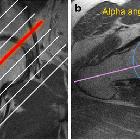Alpha angle (femoroacetabular impingement)





The alpha angle is a radiological measurement proposed for the diagnosis and evaluation of surgical treatment in cam-type femoroacetabular impingement (FAI).
When initially described in 2002, Notzli et al. suggested that the pathological value was >50°.
According to one study, a value measured in an oblique CT reconstruction of the femoral neck has been thought to have a high discriminating capacity for the diagnosis of symptomatic cam-type femoroacetabular impingement where if a patient complains of hip pain and an alpha angle ≥57° is found on CT, strongly suggest that cam-type FAI may be the cause .
The term alpha angle is also used in a separate and unrelated context in the evaluation of developmental dysplasia of the hip (DDH) in children.
Radiographic features
Plain radiograph
Measured on obliquely oriented radiographs. The Dunn projection of the hip is used.
CT/MRI
Measured on oblique axial images as the angle between the orientation of the femoral neck and the margin of the femoral head.
Siehe auch:

 Assoziationen und Differentialdiagnosen zu Alphawinkel CAM-Impingement:
Assoziationen und Differentialdiagnosen zu Alphawinkel CAM-Impingement:

